LINKS
- Attack of the 50-Year-Old Comics
- Super-Team Family: The Lost Issues
- Mark Evanier's Blog
- Plaid Stallions
- Star Trek Fact Check
- The Suits of James Bond
- Wild About Harry (Houdini)
This year marks the 50th anniversary of Volume 2 of “The Steranko History of Comics,” a work that it’s fair to say blew my mind as a kid.
I call it a “work” because I never know how to classify it: it’s crammed with enough content to qualify as a “book”, but it was packaged in the style of a tabloid-sized “magazine,” saddle-stitched with a glossy cover like LIFE or the Saturday Evening Post. And what a cover! Or actually, two covers, Volume 1 with a white background and Volume 2 in black.
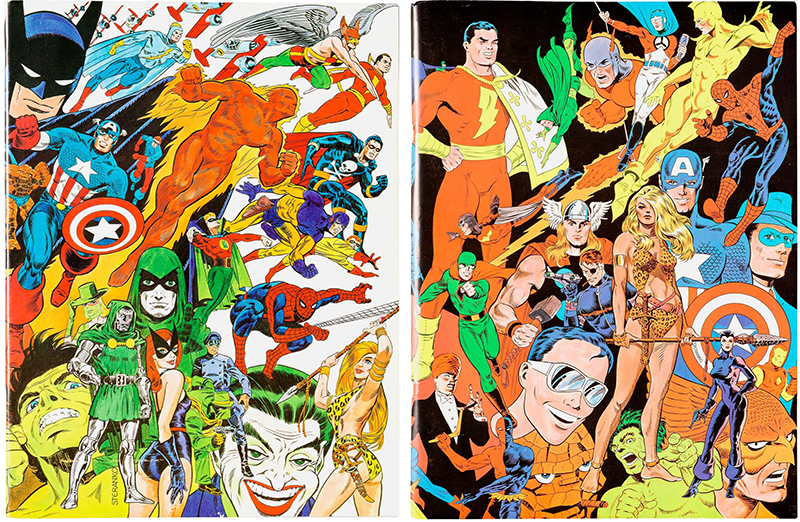
I can only imagine this oddball format created a challenge for bookstore owners: Do you display it on the magazine rack even though it’s not a “periodical” per se and doesn’t get rotated out like real mags? Or do you shelve it spine-out with books, even though there’s no title visible on that stapled spine and after all, the key to grabbing attention is that wonderful cover art?
In my case, I found Volume 1 on a store shelf grouped with other oversized tomes, and about 5 or 6 years past the initial release, which may have meant it just sat around unloved all that time or (perhaps more likely given my copy had a $4 price tag instead of the $2 tag from the start of the run), that it stayed in print for a good while. Anyway, once I’d laid eyes on it, there was no way I wasn’t going to beg, barter or cajole the necessary funds from Mom and Dad to take it home.
For both volumes, author and comic art veteran Jim Steranko created “wrap around” covers that are best appreciated when fully opened. Here’s the extended view of Volume 1’s art, featuring a fantastic mob scene of garishly colored characters, both familiar and — more excitingly — foreign to my youthful eyes, and fraternizing freely in spite of their disparate corporate loyalties and eras.
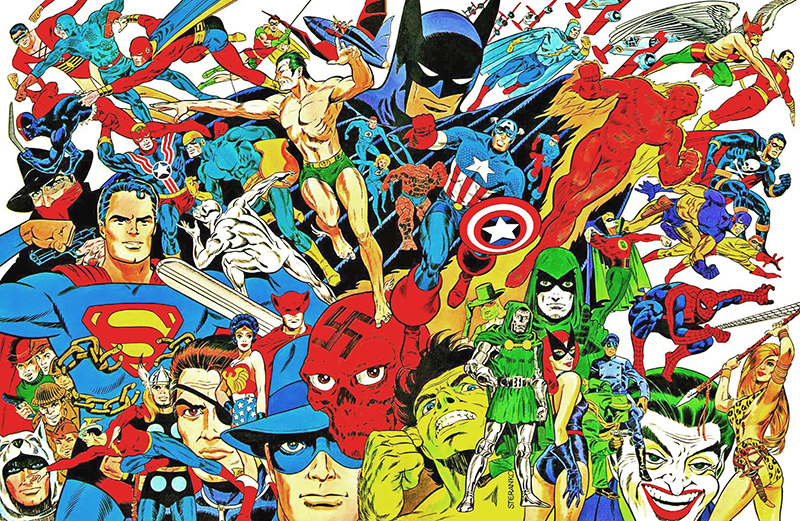
I ask you, what red-blooded comics fan could resist a cover like that? Yet, in its own way it added to the marketing difficulties, because it’s missing the minor detail of a title, let alone a price tag. Over the years, I’ve seen many variations on the cover, with variously colored titles tacked on, sometimes even applied via decal. My original copy of Vol 1 did include a printed title in a nifty blue Steranko-designed font, another clue that it came late in the print run, when the earlier oversight had been corrected. The downside is that squeezing that title in meant shifting the entire image a couple inches southward, sacrificing the Joker’s smile, Dr Doom’s feet and even Steranko’s signature. (It also meant printing the title on the front AND back of the book so that the wraparound image would still line up). But in my favor, it also cropped out Sheena and Black Cat’s butt cheeks, which may have been key to convincing my parents to approve the purchase at all.
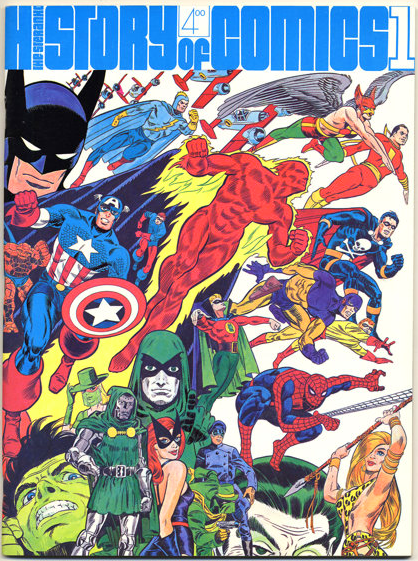
In later years, there was a “poster” version of this image available for sale and I’ve always wondered if it wasn’t just from a cache of leftover covers dating to the “Oops we forgot the title” period. Either way, I wish I had it.
Both volumes were printed by Steranko’s own “Supergraphics” company, which might explain its unconventional and perhaps not entirely thought-through format. It’s quite likely no major publisher was interested in publishing such a “deep in the weeds” and detailed history of comics that dated back to the World War 2 era and before. As strange as it may seem in this age of billion-dollar superhero films, there was a time not so terribly long ago when no one took this stuff seriously, and in fact aside from Jules Feiffer’s “The Great Comic-Book Heroes,” it’s hard to recall a contemporaneous work that took a serious approach to the subject matter. Anyway, for my money, the “self-published” vibe of Steranko’s work adds greatly to its appeal.
Those garish covers are the books’ only color images, but the interiors were a geek’s paradise. I lost myself for hours on end in Steranko’s accounts of books and characters from comics’ Golden Age, literally dozens of publishers I’d never heard of with hundreds if not thousands of forgotten characters bearing names that covered pretty much every animal, reptile or bird in nature and every action-packed verb in the English language. I’d already “met” vintage characters like Robotman, Plastic Man and the Justice Society of America thanks to reprints in DC’s “100-Page Super-Spectaculars,” but it turned out they were just the tip of the iceberg. I was convinced the Golden Age must have been the most amazing time ever to be a kid, as page after page of tiny text in multiple columns teased me with what I’d been born too late to enjoy.
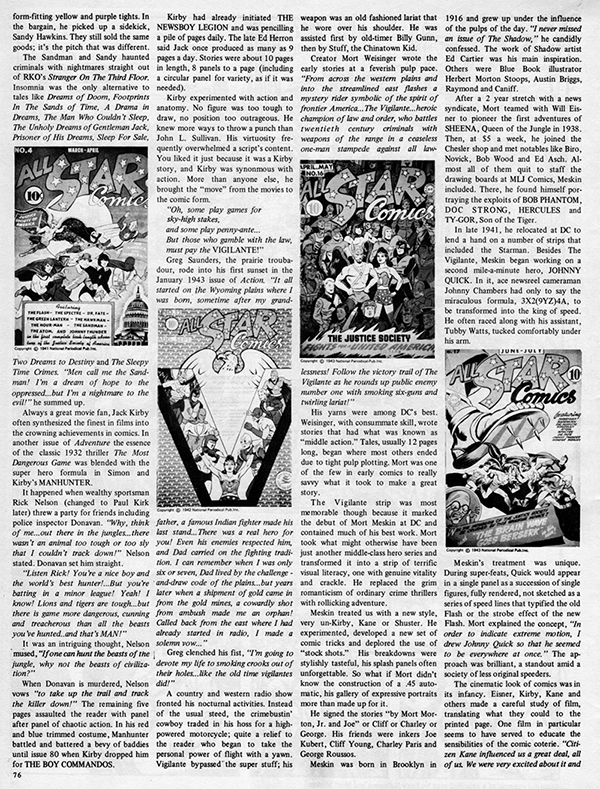
The weird part is, more time has now passed between the release of this book and the writing of this post than had passed from the Golden Age to Steranko’s book. When Volume 1 came out in 1970, it was “only” 30 years from the first appearances of Robin, Green Lantern and The Flash, and slightly less since the debuts of Captain Marvel, Captain America, The Human Torch and the Sub-Mariner. And though that seemed an eternity to me at the time (for Pete’s sake, my DAD would’ve been a kid, then!), today 30 years seems like nothing.
Of course, the good part of that was that many of the original creators were still around to contribute to the book. Accordingly, Steranko tapped great talents like Bill Everett, Jack Kirby and Joe Kubert to provide spectacular full-page illustrations of characters they had helped create.
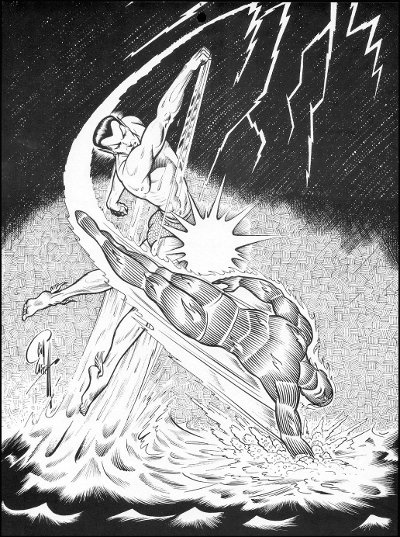
Another benefit of having an “unofficial” history like this, one unsanctioned or overseen by the major comics publishers, was that for the first time we were getting a version of history that hadn’t been filtered through company PR. So for example some of us were learning for the first time that the “Created By Bob Kane” tag on Batman comics was a work of fiction in itself.
Volume 1 also started off with a tantalizing summary of the age of Pulp heroes that predated and inspired the superhero craze. This is where I first encountered characters like Doc Savage, The Spider and The Shadow, who continue to fascinate me to this day, accounting for a decent percentage of leisure reading I once devoted to comics.
I still don’t know what might have motivated Steranko, a fan-favorite artist best known for “Nick Fury, Agent of SHIELD” and short but well-loved runs on Captain America and The X-Men to devote so much time and effort to a work of research like this, but I’ll always be grateful he did, and at a time when one could still gather first-hand accounts from surviving participants of Golden Age comic history.
Many years later — somewhere in the first years of this century — I finally got hold of a copy of Volume 2 and was able to relive a piece of my childhood with another deep dive into comic history and another stunning wrap-around cover.
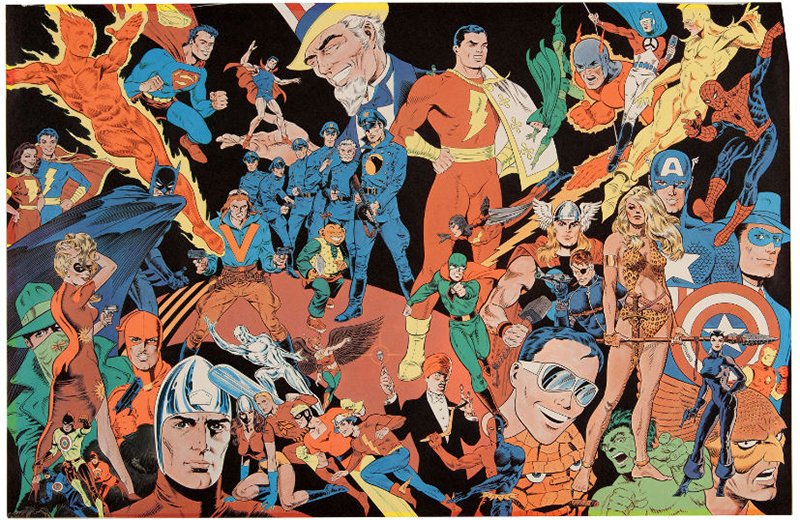
I’m still not sure of the details, but apparently there was some sort of “warehouse find” deal where a horde of unshipped copies of the original books turned up and were sold for a minimal markup; roughly twice what they went for in the 70s but still around or under 10 bucks. I was also able to snag a well-preserved copy of Volume 1 to supplement my by-then dog-eared, tattered original, barely hanging onto its cover with a staple and a prayer.
Like many fans, I’ll always wish Steranko had followed through and completed the originally planned eight volumes of this work, but even in its abbreviated form…and maybe even in a strange way because of it…it remains a wonderful, fascinating thing.
What sparked this reminiscence was a recent re-reading of a 1970 issue of The Amazing Spider-Man, wherein an advertisement announced Volume 1:
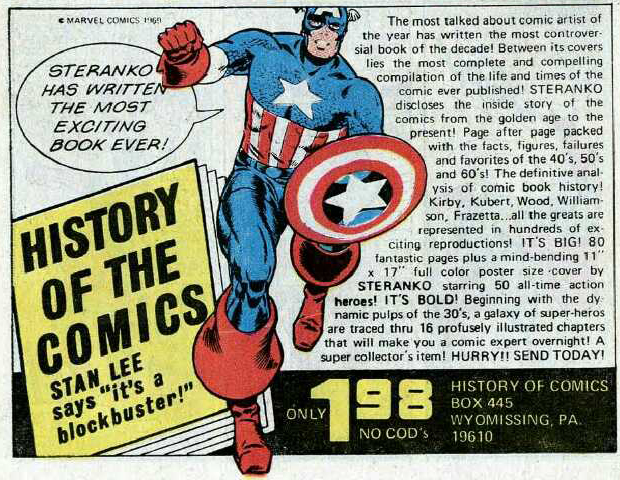
Naturally you couldn’t hope to attract attention in a Marvel comic without a smattering of bolded, all-caps text and a healthy supply of exclamation points, but young Me would have had a hard time dismissing Cap’s declaration as mere hyperbole. It may indeed have been the most exciting book ever.
Steranko was an awesome artist
I never get tired of looking at his work
Thanks for the review
Keep well
Shang